(完整版)人教版高中英语教学设计
(完整word版)人教版英语必修一第二单元-unit2教学设计
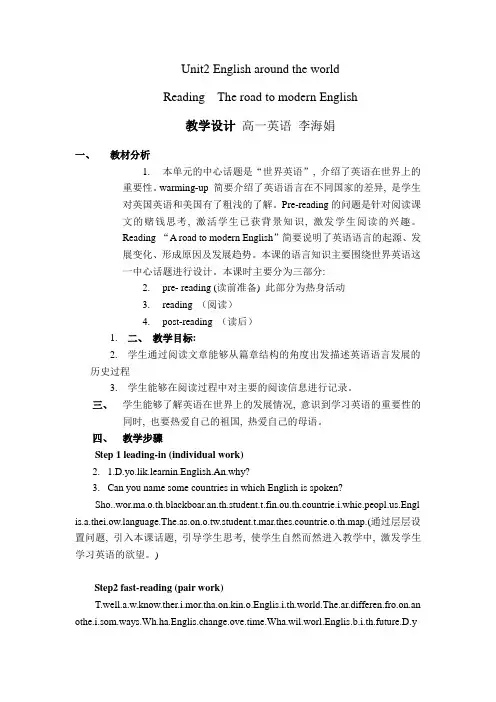
Unit2 English around the worldReading The road to modern English教学设计高一英语李海娟一、教材分析1.本单元的中心话题是“世界英语”, 介绍了英语在世界上的重要性。
warming-up 简要介绍了英语语言在不同国家的差异, 是学生对英国英语和美国有了粗浅的了解。
Pre-reading的问题是针对阅读课文的赌钱思考, 激活学生已获背景知识, 激发学生阅读的兴趣。
Reading “A road to modern English”简要说明了英语语言的起源、发展变化、形成原因及发展趋势。
本课的语言知识主要围绕世界英语这一中心话题进行设计。
本课时主要分为三部分:2.pre- reading (读前准备) 此部分为热身活动3.reading (阅读)4.post-reading (读后)1.二、教学目标:2.学生通过阅读文章能够从篇章结构的角度出发描述英语语言发展的历史过程3.学生能够在阅读过程中对主要的阅读信息进行记录。
三、学生能够了解英语在世界上的发展情况, 意识到学习英语的重要性的同时, 也要热爱自己的祖国, 热爱自己的母语。
四、教学步骤Step 1 leading-in (individual work)2. 1.D.yo.lik.learnin.English.An.why?3.Can you name some countries in which English is spoken?.Engl nguage.The.as.on.o.tw.student.t.mar.thes.countrie.o.th.map.(通过层层设置问题, 引入本课话题, 引导学生思考, 使学生自然而然进入教学中, 激发学生学习英语的欲望。
)Step2 fast-reading (pair work)T.well.a.w.know.ther.i.mor.tha.on.kin.o.Englis.i.th.world.The.ar.differen.fro.on.an othe.i.som.ways.Wh.ha.Englis.change.ove.time.Wha.wil.worl.Englis.b.i.th.future.D.yChec.th.answers.As.som.student.t.tel.thei.answers.afte.givin.th.answers.the.shoul .als.tel.ho.the.fin.th.answers.(快速阅读后要求学生了解文章大意, 并能对全文的结构有一个认识。
人教版高中英语必修1教案5篇
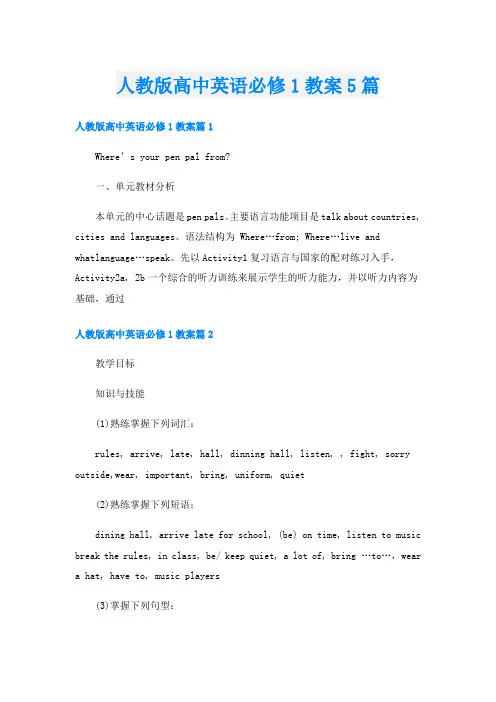
人教版高中英语必修1教案5篇人教版高中英语必修1教案篇1Where’s your pen pal from?一、单元教材分析本单元的中心话题是pen pals。
主要语言功能项目是talk about countries, cities and languages。
语法结构为 Where…from; Where…live and whatlanguage…speak。
先以Activity1复习语言与国家的配对练习入手,Activity2a, 2b一个综合的听力训练来展示学生的听力能力,并以听力内容为基础,通过人教版高中英语必修1教案篇2教学目标知识与技能(1)熟练掌握下列词汇:rules, arrive, late, hall, dinning hall, listen, , fight, sorry outside,wear, important, bring, uniform, quiet(2)熟练掌握下列短语:dining hall, arrive late for school, (be) on time, listen to music break the rules, in class, be/ keep quiet, a lot of, bring …to…,weara hat, have to, music players(3)掌握下列句型:1. Dont eat in class.2. You must be on time.3. Eat in the dining hall.4. 正确使用情态动词can, can’t——Can we wear a hat in school?——Yes, we can./No, we can’t.5. 能正确使用have to 和 must 谈论规章制度We must be on time/ We also have to be quiet in the library. 教学重难点重点:1) 肯定祈使句是省略掉主语的原形动词开头;2) 否定祈使句则是在肯定祈使句前加上“don’t”。
高一英语教案人教版(精选5篇)
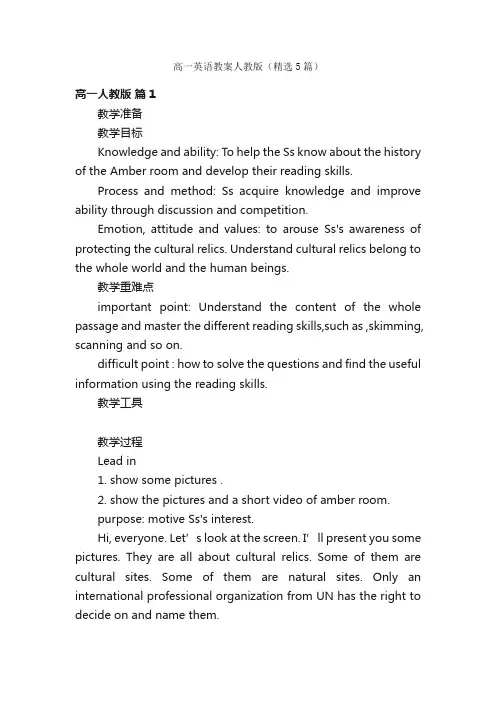
高一英语教案人教版(精选5篇)高一人教版篇1教学准备教学目标Knowledge and ability: To help the Ss know about the history of the Amber room and develop their reading skills.Process and method: Ss acquire knowledge and improve ability through discussion and competition.Emotion, attitude and values: to arouse Ss's awareness of protecting the cultural relics. Understand cultural relics belong to the whole world and the human beings.教学重难点important point: Understand the content of the whole passage and master the different reading skills,such as ,skimming, scanning and so on.difficult point : how to solve the questions and find the useful information using the reading skills.教学工具教学过程Lead in1. show some pictures .2. show the pictures and a short video of amber room.purpose: motive Ss's interest.Hi, everyone. Let’s look at the screen. I’ll present you some pictures. They are all about cultural relics. Some of them are cultural sites. Some of them are natural sites. Only an international professional organization from UN has the right to decide on and name them.PresentationLook at the photos here. What do you know about the substance of “amber”? What do knowabout the cultural relics “the Amber Room”?discussion:Now, boys and girls, I met a “moral dilemma”. That means I must make a choice between the interests of the family and the interests of the society. Things are like this: My old granny happened to find an ancient vase under a tree in the earth of our garden. It’s so beautiful and special. Now, my family fell into a moral dilemma. Can you help us to make a decision?A: What should we do?B: Can we keep it for ourselves or report it to the government?C: Have you come across such a situation —to make a difficult choice?listen and answer the questions:Play tape. Ss get the main idea of the passage.Readingpre-reading:1. Have you ever seen a piece of amber?What do you know about it?2. look at the title and the picture. predict what it is about. Then skim it quickly and see if you were right.Reading:1st time:read by yourself as quickly as you can.join the correct parts of the sentences together.2nd time:choices and T/Fcompete between boys and girls.3rd time:answer some question. Ask ss to think over and discuss.purpose: understand the text better and arouse Ss's awareness of competition. Grasp the main information.Discussion and reportThink over of what we discuss in the part of warming up: I find myself falling into the dilemma.you discuss together ,and write down the outline of a report.work in groupConsolidationfill in the blanks (summary).Homeworkmake a report .use the useful information in the passage.高一英语教案人教版篇2教学准备教学目标掌握住列举的重点单词和句子教学重难点掌握住列举的重点单词和句子并能灵活运用教学过程Ⅰ.重点单词1.________ vi.爆裂;爆发n.突然破裂;爆发2.________ n.事件;大事3.________ n.废墟;毁灭vt.毁灭;使破产4.________ adj.极度的5.________ vt.破坏;毁坏;消灭6.________ vt. & vi. (使)震惊;震动n.休克;打击;震惊7.________ n. & vt.援救;营救8.________ vt.使陷入困境n.陷阱;困境9.________ n.灾难;灾祸10.________ vt.埋葬;掩埋;隐藏11.________ n. & vt.损失;损害12.________ n.裁判员;法官vt.断定;判断;判决13.________ vt.损害;伤害→________ n.伤害;损害→________ adj.受伤的14.________ n.电;电流;电学→________ adj.用电的;带电的→________ adj.与电有关的;电学的15.________ vt.使惊吓;吓唬→ ________ adj.受惊的;受恐吓的→ ________ adj.令人恐惧的16.____________ n.祝贺;(复数)贺词→ _____________ vt.祝贺Ⅱ.重点短语1.a (great) number ________许多;大量的2.dig ________掘出;发现3.________ an end结束;终结4.right ________立刻;马上5.as ________仿佛;好像6.________ ruins严重受损;破败不堪7.think little ________轻视,满不在乎8.tens ________ thousands of数以万计9.be proud ________以……自豪10.judge ________从……判断11.be trapped ________陷入12.be buried ________埋头于13.put ________ shelters搭建避难所14.get away ________离开15.pay attention ________注意Ⅲ知识点教案EX.2 On seeing Jay Chow appear on the stage, the audience burst out _________ (cheer).burst with anger/ joy勃然大怒burst n.突然破裂;爆发a burst of laughter一阵笑声2.n.废墟,遗迹(常用复数形式);毁灭be/lie in ruins成为废墟;严重受损;破败不堪EX.1 All the towns were/lay in _____ (ruin) after the earthquake.vt.毁灭;使破产ruin oneselfruin one’s health/fame/futureEX.2过量吸烟损害健康,因此你应该戒烟。
高中英语教学设计
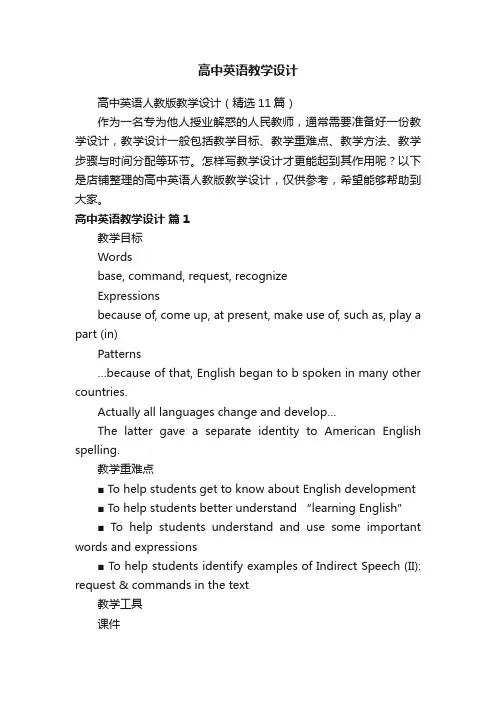
高中英语教学设计高中英语人教版教学设计(精选11篇)作为一名专为他人授业解惑的人民教师,通常需要准备好一份教学设计,教学设计一般包括教学目标、教学重难点、教学方法、教学步骤与时间分配等环节。
怎样写教学设计才更能起到其作用呢?以下是店铺整理的高中英语人教版教学设计,仅供参考,希望能够帮助到大家。
高中英语教学设计篇1教学目标Wordsbase, command, request, recognizeExpressionsbecause of, come up, at present, make use of, such as, play a part (in)Patterns…because of that, English began to b spoken in many other countries.Actually all languages change and develop…The latter gave a separate identity to American English spelling.教学重难点■ To help students get to know about English development ■ To help students better understand “learning English”■ To help students understand and use some important words and expressions■ To help students identify examples of Indirect Speech (II): request & commands in the text教学工具课件教学过程⑴Warming up by listingGood morning, class. We have been learning English for several years. But how many English-speaking countries are there in the world? Now let’s ma ke a list of them on the blackboard.English Countries ExplanationMother tongue the United Kingdomthe United States of AmericaCanadaAustraliaSouth AfricaIrelandNew Zealand The people in these countries are native speakers of English. In total, for more than 375 million people English is their mother tongue.Second language IndiaPakistanNigeriathe Philippines These people speak the language of their own country at home but the language of the government, schools, newspapers, and TV is English.Foreign language ChinaGermanyFranceetc. The number of people who learn English as a foreign language is more than 750 million.⑵Warming up by answering questions about EnglishGood morning, class. Today we shall start learning Unit 2 English around the world. But how much do you know about English?●What is Standard English?Standard English is the form of English that most people in Britain use, and that is not limited to one area or group of people.●What is a dialect?A dialect is a variety of a language spoken only in one area, in which words, or grammar are slightly different from other forms of the same language.●Do we have standard Chinese? What is it?In China there’re so many dialects that the government encourages the whole nation to speak Putonghua, which is regarded as standard Chinese.⑶Warming up by giving reasonsUnit 2 English around the world is what we are going to learn today. We are all learning English now because English is so popular in the world. But do you know why it is so? How many reasons could you giving for the spread of English around the world?x English is one of the official languages of the Olympic Games and the United Nations.x English dominates international websites and provides nearly all of the new computer terminology.x Tourism and trade from Western Europe and North America has contributed to the spread of English.x Satellite TV, radio programs like Joy FM, CDs and, of course, Hollywood films all broadcast English into China. Also, a number of Chinese films include English subtitles.2.Pre-readingWe are learning English here. But why are we learning it? Could you suggest to the class as many reasons as you can think of, why people in the world learn English?for work, as a hobby, to learn about other people, to travel, to read literature in the original, to read research papers, to meet foreigners, to surf the Internet, to pass exams, etc.Go on with your reasons. I shall write your suggestions on the board as you make them.3. Skimming the text for general ideasNow we go to page 9 to skim the text for the main idea of each paragraph.Paragraph 1: The spread of the English language in the world Paragraph 2: Native speaker can understand each other even if they don’t speak the same kind of English.Paragraph 3: English changes and develops when cultures meet and communicate with each other.Paragraph 4: By the 19th century English is settled.Paragraph 5: English is spoken as a foreign language or second language in South Asia.4. Reading and fillingRead the text to complete the chart below.Time English is influenced by…AD 450-1150 German1150-1500 FrenchIn the 1600’s Shakespeare, who make use of a wider vocabulary than ever beforeBy the 19th century Samuel Johnson, Noah WebsterNow Languages in South Asia, in Singapore, in Malaysia, in Africa and in China5. Reading and copyingNext we shall go over the text once more. This time try find and copy all the useful expressions down in your notebook.Useful expressionsat the end of…, make voyages, speak English as…, in the next century, change over time, communicate with…, be based on…, at present, become less like…, rule England, enrich the English language, make use of…, move to…, later in the 18th century, give a separate identity to…, have a very large number of…, fluent English speakers, become the language for…, develop one’s own identity, increase rapidly高中英语教学设计篇2教学目标:1.To have a good review of the key words and phrases and be able to write the good and bad things about computers .2.To learn by ourselves and cooperate with each other.3.To be a hard-working,and practical student.教学重难点1.To have a good review of the key words and phrases and be able to write the good and bad things about computers .2.To learn by ourselves and cooperate with each other.3.To be a hard-working,and practical student.教学过程一.必考单词速记1.事实n. ________________2. (电脑)操作员,接线员__________3.性格;特点______________4.科技;工艺_______________5.目标,目的n. ______________6.出现;发生vi. ______________7.解决;解答vt. _______________8.类型,打字v.& n.____________9.发信号vi.& n ;信号._________10.无论如何,即使如此adv. ______二.写出下列单词的变化形式1. operator n.操作员;接线员→_____________v.操作;经营→____________n.操作;经营2. technology n.工艺;科技;技术→_______________ adj.科技的3. intelligence n.智力;聪明;智能→_________adj.智能的;聪明的4. appearance n.外观;外貌;出现→________________vi.出现5. application n.应用;用途;申请→_______________v.应用;申请→___________n.申请人;求职者6. explore vt.& vi.探索;探测→___________n.探险家;勘探者→_____________ n.探索7. personal adj.私人的;个人的;→________adv.就个人而言;亲自→_________n. 个性;人格;三、用所给词的适当形式填空(1)Can you say dolphins are much more ____________than other animals?Well, they are animals of high _____________. (intelligent)(2) She expressed her _________ opinion yesterday. ____________ speaking, I agreed with what she said. (personal)(3) Any ___________ who would like to _____________ to become anassistant in our company should send us an ___________ .(apply)四、语境助记——词不离句,句不离段With the electronic technology revolution going on,simplified calculation is solved in the application on finance by universal exploration. Our goal of making life happier is certain to be realized through man's intelligence.五、翻译下列必背短语?1.在某种程度上_______________2.依…看;据…认为_____________3.从…时候起_______________4.结果_______________5.处理;安排;对付____________6.弥补,补足;整理,编造_________7.毕竟_______________?8.看守,监视_______________9.在……帮助下_______________?六.根据句子意思写出单词的正确形式。
人教版高中英语优秀教学教案模板_人教版高中英语优秀教学教案设计
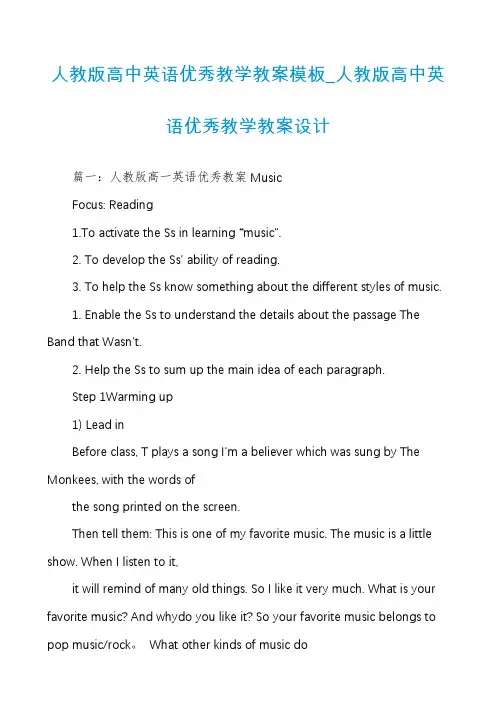
人教版高中英语优秀教学教案模板_人教版高中英语优秀教学教案设计篇一:人教版高一英语优秀教案MusicFocus: Reading1.To activate the Ss in learning “music”.2. To develop the Ss’ ability of reading.3. To help the Ss know something about the different styles of music.1. Enable the Ss to understand the details about the passage The Band that Wasn’t.2. Help the Ss to sum up the main idea of each paragraph.Step 1Warming up1) Lead inBefore class, T plays a song I’m a believer which was sung by The Monkees, with the words ofthe song printed on the screen.Then tell them: This is one of my favorite music. The music is a little show. When I listen to it,it will remind of many old things. So I like it very much. What is your favorite music? And whydo you like it? So your favorite music belongs to pop music/rock。
What other kinds of music doyou know?(classical music, pop, folk, jazz, dance, rock and roll, hip-hop, rap etc.)2) Task: Brain-stormingAsk the students to name different music styles. Show some styles of music that they are notfamiliar with.folkpopStep 2 Listening and Matching1)Tell Ss: we are going to listen to eight kinds of music. Here are the pictures for them. Listento them carefully and choose the proper picture for each of them.2) Guide the Ss to sum up the Characteristics for each music style.3) Check the answers on the puter screen.Step 3 Pre-reading1)Task :ListingHave you heard about any of the famous bands in the world? List some of them.Which one do you like best? Why?2) PresentationAsk the Ss to search the information about “The Monkees” before class, and now encourage them to share their information with theirteammate.3) Background information and language supportIf necessary , the teacher should provide some background information about “The Monkees” , or explain some key words in the reading passage (P 35, Learning about language part 1 may be a good choice. )Step 4While-reading1) Task: Jumbles (Fast reading)(Group work, four Ss) each student in every group is only given a part (one paragraph)of the plete article and read alone. One minute later, they exchange their own information to the other students of the same group. Then they discuss together and decide the order of the story.2) Listen and CheckListen to the tape and check the correct order of the article.Q: What is the best title of the article?3) Task : Memory Challenge Task (Scanning)(Students are given the plete pieces of the article—ask them to open their books.)Get them to read the passage in detail and then work in group raising two questions for other group to answer.(books closed)4) Reading and MatchingRead the passage again very carefully, and join the parts of the sentences together. (P 35, Part 2)More detailed questions:①Why do most musicians like to be in a band with others?②W hich two musical bands are mentioned in the passage?③How do some bands formed by high school students earn extra money?④When did the Monkees break up?5) BrainstormingAsk the Ss to brainstorm as many suitable adjectives as possible to de scribe “The Monkees”. Then give the reasons for the choices.Step 5Post-reading1) Language FocusGet the students to sum up the phrases of the article.Then get the Ss to play a game called “What is your dream?”. Work in pairs and tell each other your dream and what you expect to happen. Use the phrases dream of and be honest with in the sentences.2) DiscussionDo you think “The Monkees” was really a band? Why and why not?Step 6Homework1. Read more about “The Monkees”.2. Find out some sentences in the reading passage that contain of Whom /in which attributive clauses?3. Preview “Learning about Language” and finish the relevantexercises.Period 3 Vocabulary GrammarFocus: Grammar1)To help Ss master the vocabulary about “music”2)To arouse Ss’ language awareness .3) To consolidate the Attributive Clauses.1) The Attributive Clauses with preposition + which/ whom2) The relevant words about “music”Step 1 Revision1) Listening and RecognizingAsk the Ss to listen to some pieces of music from the puter and write down the style of each piece of music belongs to.Music 1 : Country Roads by John Denver (country music)Music 2: Beat itby Michael Jackson (rock music)Music 3: 步步高(folk music)Music 4: 老鼠爱大米(pop music)Music 5: 命运交响曲(classical music)。
人教版高中英语教案三篇
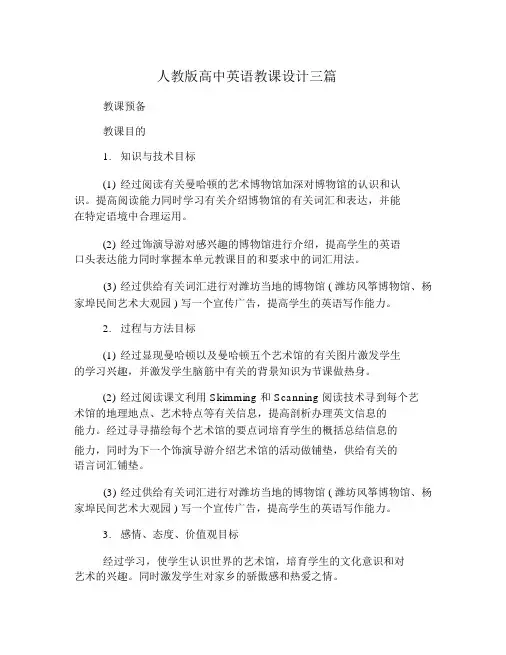
人教版高中英语教课设计三篇教课预备教课目的1.知识与技术目标(1)经过阅读有关曼哈顿的艺术博物馆加深对博物馆的认识和认识。
提高阅读能力同时学习有关介绍博物馆的有关词汇和表达,并能在特定语境中合理运用。
(2)经过饰演导游对感兴趣的博物馆进行介绍,提高学生的英语口头表达能力同时掌握本单元教课目的和要求中的词汇用法。
(3)经过供给有关词汇进行对潍坊当地的博物馆 ( 潍坊风筝博物馆、杨家埠民间艺术大观园 ) 写一个宣传广告,提高学生的英语写作能力。
2.过程与方法目标(1)经过显现曼哈顿以及曼哈顿五个艺术馆的有关图片激发学生的学习兴趣,并激发学生脑筋中有关的背景知识为节课做热身。
(2)经过阅读课文利用 Skimming 和 Scanning 阅读技术寻到每个艺术馆的地理地点、艺术特点等有关信息,提高剖析办理英文信息的能力。
经过寻寻描绘每个艺术馆的要点词培育学生的概括总结信息的能力,同时为下一个饰演导游介绍艺术馆的活动做铺垫,供给有关的语言词汇铺垫。
(3)经过供给有关词汇进行对潍坊当地的博物馆 ( 潍坊风筝博物馆、杨家埠民间艺术大观园 ) 写一个宣传广告,提高学生的英语写作能力。
3.感情、态度、价值观目标经过学习,使学生认识世界的艺术馆,培育学生的文化意识和对艺术的兴趣。
同时激发学生对家乡的骄傲感和热爱之情。
教课重点教课要点:文、运用文中有关行和写的活以提高学生、写、的能力。
教课点:在和写的程中怎样运用有关和表达方式来正确、正确、有效的介各个的特点。
教课程( 一) 显现学目与小价( 二) “ 入”显现曼哈的有关片,显现文中出的名字。
5 个的片及( 三) Fast reading迅速文( 四)Detailed Reading:( 五)Challenge your speaking(口能力提高)供给参照:Welcome to ⋯This museum is located in⋯ofIt displays(展出) art⋯countries, includingworksin ⋯⋯centuries It will appeal to⋯You shouldn ’t miss ⋯( 六)Challenge your writing (英写作能力提高) Watch the videos and then write an advertisement tointroduce one of the museums in Weifang. within80 words写作参照:坊世界筝博物 (Weifang World Kite Museum)家埠民大园 (Yangjiabu Folk Art Museum)kite located in 筝 wood-print new year pictures位于木板年画be⋯is famous/well- known for⋯因⋯而有名it displays/shows⋯展出Here you can enjoy appeal to吸引tourist ⋯在里你能够欣到⋯artist旅客 it ’s well worth a visit家很得参( 七) 成就显现个学生秀作文显现( 黑板显现 )显现作文分教点后一:从文中出相的短和句子。
高中人教版英语教案
高中人教版英语教案(总21页) --本页仅作为文档封面,使用时请直接删除即可----内页可以根据需求调整合适字体及大小--高中人教版英语教案【篇一:人教版高中英语教学设计】人教版高中英语教学设计人教版高中英语必修5 unit 2 the united kingdom一.教学内容分析:人教版新课标高中英语必修5 第二单元 (the united kingdom ) using language sightseeing in london让学生了解英国首都伦敦的名胜古迹( bigben;stpaul’scathedral ;westminsterabbey;greenwich;highgate cemetery)二、教学目标(teaching goals)1.目标语言(target language)a. 重点词汇和短语sightseeing, available, delight, tower, royal, uniform, splendid, statue, communism, thrillb. 重点句式worried about the time available, zhang pingyu had ... p14 what interested her most was the longitudeit seemed strange that the man who had developed communism should have lived and died in london. p14but she was thrilled by ... p142. 能力目标(ability goals)improve the reading ability of the students and enable the students to plan a tour around certain places.3. 学能目标learning ability goalshelp the students know more about the historical sites in london.三、教学重难点(teaching important difficult points)help the students identify different kinds of tour andtalk about the most interesting place for the tour and master the key words and expressions in the passage.四、教学方法(teaching methods )1、任务型教学法(task-based teaching method)。
2024年人教版高中英语备课教案
2024年人教版高中英语备课教案一、教学目标在本节课的教学中,旨在达成以下三个目标:语言知识目标:使学生掌握本节课所学的词汇、短语和句型,能够正确理解和使用相关语言点。
语言技能目标:通过听说读写等多方面的训练,提高学生的综合语言运用能力,使学生能够用英语进行有效的交流。
学习策略目标:培养学生自主学习和合作学习的能力,引导学生掌握有效的学习策略,提高学习效率。
二、教学重点和难点教学重点:重点词汇和短语的用法。
重点句型的结构和运用。
课文的理解和语言点的掌握。
教学难点:语法点的理解和运用。
文化背景知识的介绍和理解。
学生个体差异导致的语言运用问题。
三、教学过程1. 导入新课(Leading-in)通过提问、讨论或展示相关图片、视频等方式,激发学生的兴趣,为新课的学习做好铺垫。
引导学生回顾与新课内容相关的旧知识,帮助学生建立知识之间的联系。
2. 呈现新课(Presentation)清晰地讲解新词汇、短语和句型的意义及用法,通过例句和语境帮助学生理解。
展示课文内容,引导学生阅读并理解,同时解释其中的语言点和文化背景知识。
3. 练习巩固(Practice)设计多层次的练习活动,包括填空、选择、翻译等,以巩固学生对新知识的理解和记忆。
通过小组讨论、角色扮演等活动,提高学生的语言运用能力和合作学习能力。
4. 运用拓展(Application)提供与现实生活相关的情境,让学生运用所学知识进行实际交流,培养语言运用的能力。
鼓励学生提出自己的问题和观点,进行开放性的讨论,培养学生的批判性思维和创新能力。
5. 总结反馈(Summary & Feedback)对本节课的知识点进行总结,帮助学生形成清晰的知识框架。
收集学生的反馈,了解学生的学习情况和困难,为后续教学提供参考。
四、教学方法和手段教学方法:采用任务型教学、合作学习、情境教学等多种教学方法,激发学生的学习兴趣,提高教学效果。
教学手段:利用多媒体课件、实物、图片、视频等多种教学手段辅助教学,使教学更加生动形象。
人教版高中英语的备课教案5篇
人教版高中英语的备课教案5篇人教版高中英语的备课教案1(一)明确目标1. Read through the text live to ride.2. Understand “live to ride”.3. Learn to write a description.(二)教学过程Step1 Warming upTask 1Report about the passages found the day before.T: Yesterday we have the work --- to find and read a few passages about theme parks. So now please describe the thing you have got in hand.Students may talk more about rides, skiing, rafting, surfing, skydiving, adventure travels or other adventure activities.Task 2 Read the information below and make up a dialogue.Notice: This is taken from a website of the U.S. It’s about a kind of roller coaster. Students will find much detail in it.设计意图:以生活实际例子为引导,可操作性强。
Ant Farm ExpressType: Steel - Mine Train Height: 41 Feet Train Type: 30 Passengers Designer: Arrow Dynamics Drop: 32 Feet # of Trains: 3Year Built: 1971 Top Speed: 37 MPH Elements:Ride Time: 3 Minutes Length: 2,350 Feet # of Inversions: 0Color: yellow G-Force: Other:Comments: Operated at Dolly wood 1989-1998 as the Thunder Express.Also operated as one of two mine train tracks called the River King Mine Train at Six Flags St. Louis from 1971 to 1988. Relocated herein 20__.Photos: ……Students may raise questions as follows:What’s the nameWhen was it builtHow many passengers can it take at a timeWhat is the lengthHow high can it goWhat about the top speedAre there any comments about it … …Step2 ReadingTask 1 SkimmingQuestion:What attraction can be found important in theme parks → Rides, the “thrill ride” …Task 2 ScanningQuestions:1. How do people ride roller coasters nowadays2. What is a thrill ride likeAnswers:1. Rides are wider and scarier than ever.The cars run faster, the tracks are higher, and people go through twists, loops, and drops. Some let people race against their friends. Some ride through darkness inside a mountain and a building.2. Very exciting and scary.Thrill rides use speed, motion, and special effects to give you aSome let you feel what it is like to fall through the air.Some rides send you through caves and even rivers.Thrill rides can also send you into space or deep down in the ocean.Task 3 DiscussingGroup Work Question: What else can we do in a thrill rideS1: We can dash through the snow during the ride.S2: We will ride together with some animals.S3: The car rides in a desert. … …Summary:We can imagine so man y ways, but it’s still not enough.The only limit to the fun is the imagination of the designers ofthe thrill rides. It seems to be endless.Quote: The great progress in science roots in completely new and brave imaginations of the human beings. ---- Dewey“科学的伟大进步源自于崭新与大胆的想象力。
人教版高中英语必修1全部教案设计
Unit 1 Friendship 1.Teaching aims and demands语法直接引语和间接引语(1):陈述句和疑问句陈述句“I don ' want to set down a series of facts in a diary.Said Anne.-- Anne said that shedidn ' Want to set down a series of facts in a diary.一般疑问句He asked Are you leaving tonigh?”---He asked us whether we were leaving that night.特殊疑问句“ When did you go to b edast nigh?” fathe said to Anne.---Father asked Anne when she went to bed the night before.1)Suggested teaching notes2). Analyses of the teaching contentsThis unit is about friendship, and nearly all the teaching materials center on it.Warming up---The questionnaire leads students to think and talk about friendship, get to know the problems between friends and seek solutions, which makes preparations forthe further teaching in topics, background and vocabulary.Pre-reading---The questions prompt students to think critically about friends and friendship in reality, alerting them to the fact that besides people, a diary can be afriend, too.Reading--- The diary by the Jewish girl Anne gave a glimpse of her life during her family ' s shelter in Amsterdam from the GermanNazis ’ lkliing in world war 2. she treats the diary as her best friend, and init revealsher longing for a normal life and close contact with nature, which helpsher get through the days.Comprehending---It helps students further understand the text by doing multiple choices, questions and answers, and matching.Learning about language---It teaches the important expressionsand structures andgrammar: direct and indirect speeches.Using language---The two letters, listening, questionnaire design, letter writing and fun writing prepares students to further talk about friendship, especiallythe problems with misunderstanding, and unfriendliness, thusstrengthening students ’ abilities to practice language, discover, and solveproblems.Summing up---It summarizes the whole contents of this unit from the aspects of topics, vocabulary and grammar.Learning tip--- This part encourages students to form the habit of writing a diary.Integrating skills--- The text introduces the way Hawaiians express friendship, to get students to realize the cultural differences in the values of friendship in additionits importance in all cultures.3)Making of the teaching planThis unit centers on friends and friendship, exploring different types of friendshipwith particular attention to that one can develop with oneself, i.e., the comfort andsupport one seeks from an imaginary friend. Students are expected to come to be trulyaware of the qualities and conducts that make a good friend, display and develop the ability to cope with misunderstanding, conflicts and problems related to friendship, and give advice on it. The concept that even an ordinary thing can be a friend should break down the traditional belief in the interpersonal nature of friendship. Also, the comparison of similarities dissimilarities in friendship comprehension between the East and the West leads students to know better the values of friendship in Westerns eyes. All in all, this unit promises to unveil the true essence of friendship and helps students to lead a more friendly and harmonious life. Thus, based on the theme, contents and teaching objectives, the whole teaching procedures can fall into five periods as follows:4)Teaching plans for each periodPeriod 1 Warming-up and Speaking1.Teaching objectives:1)Target languageI (don ' t) think ...... I (don ' t) think so. I (don ' t) agree.I believe ............. That ' s correct. In my opinion, ••2)Ability goalsa.Describe your friends in Englishb.Figure out the problems between friends and then find different ways to solve theproblems.3)Learning ability goalsa.To encourage students to think and talk about friends and friendship by using somephrases and structures.b.To learn to solve problems that may occur between friends.c.To cultivate the students to form the good habit of learning English in Senior MiddleSchool.2.Teaching important points:e the given adjectives and sentence structures to describe one of your friends.b.Learn to evaluate friends and friendship.3.Teaching difficult points:a.Work together with partners and describe one of your good friends.b.Discuss with partners and find out ways to solve the problems.4.Teaching methodsa.Task-based teaching and learningb.Cooperative learningc.Discussion5.Teaching aids:CAI6.Teaching procedures and ways:Step 1 Lead-in and Warming-upBefore the lesson, the teacher can arousethe students ’interests by showing a video of Auld Lang Syne.At the beginning of the first class, we can get the students to talk about their summer holidays. The students can talk freely as they like.1.How did you spend your summer holidays? How did you feel? What did you do inyour summer holidays? What did you do in your spare time?2.What do you think of our new school? Do you like it? Could you say somethingabout it?3.Do you like making friends? How do get in touch with your friends? Do you havemany friends? Where are they now? Do you have any old friends in our school?Have you made any new friends in our class?Step 2 Think it over1.Give a brief description of one of your friends. The following phrases and structuresmay be helpful:His/Her name is .........He /She is ....... years old.He / She likes ....... and dislikes .......He /She enjoys ......... and hates .....He /She is very kind/friendly/ ...When /Where we got to know each other.2.What types of friendship do you have?Pleasetick them out. Then fill in the blanks.girl friends boy friends pen friendslong -distance friends friends of the same agee-friends (friends over the internet) friends across generations unusual friends like animals, books ...1). _____is /are most important to you.2). You spend most of your free time with .3). You will share your secrets with .4). When in trouble, you will first turn to .Step 3 Make a survey1. List some qualities of a good friend or your ideal friend. Have the students get into groups of four to find out what each has listed.Tell your partner your standards of good friends by using the following structure:I think a good friend should (not) be ...In my opinion, a good friend is someone who ...1.Have a member of each group report on what their lists have in common and list them on theboard.2.Ask the class whether or not they agree with all the qualities listed.3.Then have the students do the survey in the textbook.4.Have the students score their survey according to the scoring sheet on page 8.5.The teacher ask some students how many points they got for the survey and assesstheir values of friendship:★4~7 points: You are not a good friend. You either neglect your friendor just do what he/she wants you to do. You should think more about what a good friend needsto do.★8~12 points: You are a good friend but you sometimeslet your friendship become too important, or you fail to show enough concern for your friend feelings. Try to strike a balance between your friend ' needs and your own responsibilities.★13+ points: You are an excellent friend who recognizes that to be a good friend you need balance your needs and your friend ' s. Well done.(You may also show your students the results above and let themselves self-reflect upon their own values of friendship)Step 4 Talking and sharing (work in pairs)1.If your best friend does something wrong, what will you do?Try to use the following phrases:I (don ' t) think ...... I (don ' t) think so.I (don ' t) agree. I believe ............That ' s correct. In my opinion, ........2.A British newspaper once offered a prize for the best definition(义)of a friend. If youwere the editor, choose the best one from the following entries保目),and explain why.One who understands my silence.A friend in need is a friend indeed.Friends are just the people who share your happiness and sorrow. When you look at your watch at 4 am, but still know you can call them and wake them up, and they still want to talk to you, that friendship. To' have a friend, you need to be a good friend.Step 5 Group work (output)The teacher can give each group one of these questions below to talk about. Then let the class sharetheir ideas. It ' better to stimulate the students to expresstheir own opinions about these questions.1.Do you think it is a good idea to borrow money from your friend?Why and Why not?2.What factors may cause the breakdown of a good friendship?3.What can be your unusual friend besides human beings? And why?Step 6 Homework1.Write down a short passage about your ideas /the factors/your unusual friends.2.Prepare for the new lesson.Period 2 Reading Anne ’ s Best Friend1.Teaching objectives:1)To develop the students r’ eading ability, learn to use some reading strategies such asguessing, key sentences, skimming and so on;2). To get the students to realize the importance of friends and friendship, and to telltrue friends from false friends;3). To grasp some useful words and expressions in this passage, such as on purpose, be crazyabout etc.;4). To learn the writing style of this passage.2.Teaching method: Task-based teaching3). Teaching procedure:Step 1.Pre-reading1.Please enjoy three pieces of music and find out what they are about.2..Why do you think friends are important to you?3.What do you think a good friend should be like? List the good qualities a good friendshould have.4.Have you ever considered making friends with animals, plants or even an object?Why or why not?Step 2.Reading1.Try to guess what Anne ’ s friend is and what the passage is about by reading the titleand having a quick at the pictures in this passage without reading it.2.Skimming the first two paragraphs to confirm your guessing.1)What was Anne ’ s best friend? Why did she make friends with it?2)Did she have any other true friends then? Why?3)What is the difference between Anne ’ s diary and those of most people?4)Do you keep a diary? What do you think most people set down in their diaries?5)We are going to read one of Anne ’ s diaries .but before reading ,can you tell me what the diary is about with the help of one key sentence in the 2nd paragraph?3.Reading of Anne ’ s diaryHow she felt in the hiding placeTwo examples to show her feelings thenStep 3.Post-reading1.What would you miss most if you went into hiding like Anne and her family? Giveyour reasons.2.Group workWork in groups to decide what you would do if your family were going to be killedjust because they did something the Emperor did not like.Where would you plan to hide?How would you arrange to get food given to you every day?What would you do to pass the time?3.Discovering useful words and expressionsComplete the following sentences, using words and expressions from Reading1)She has grown ________ about computer games.2)Was it an accident or did David do it on ___ ?3)From the beginning ,Paul made it clear that he would be ____ (完全地)incontrol.4)He used to work ______ even in the middle of winter.5)Just the _____ of more food made her feel sick.6)You had better have a ________ talk with him.7)Born in a poor family, the manager _______ lots of hardships in his childhood.8)A diary is often kept to _____ what happenins people ’ s daily lives.Step 4.Talking about friends and friendship1.T here are many proverbs about friends and friendship. Choose the one you agree with and explain why, then choose one you disagree with and explain why.A friend in need is a friend indeed.Friends are like wine; the older, the better.A friend to all is a friend to none.The same man cannot be both friend and flatterer僦奉承者).False friends are worse than open enemies.Walking with a friend in the dark is better than walking alone in the light.2.W e have talked about friends and friendship today, can you write one or two sentences to express your understanding of friends and friendship.Step 5.Homework:1.I nterview a high school student, a businessman, a police officer and a housewife to findout their opinions about friends and friendship. Write a report to share itwith the whole class.2.Describe one of your best friends following the writing style of this passage.Ending: Let ’ s sing this song about friends togetherPeriod 3 Grammar1..Teaching objectivesLearn to use direct speech and indirect speech2.Teaching important pointSummarize the rules of Direct Speech and Indirect Speech.3.Teaching difficult pointLearn about the special cases in which the tenses shouldn ed. ’ t be chang4.Teaching methodsDiscussing, summarizing and practicing.5.Teaching proceduresStep1 Lead inT: In the last lesson, we learned Anne Frank ’ s story. She is telling herstories to twher friends—you and Tom. Tom has something wrong with his ears, so you have to repeat Anne ’ s sentences, using indirect speech. Sometimes you explain Tom sentences to Anne.“I have to stay in the hiding place." said Anne. —Anne said she had to stay in the hiding place.“ Do you feel sad when you are not able to go outdoors? ” Tom asked Anne.Tom asked Anne if/whether she felt sad when she was not able to go outdoors.I don ’ t want to set down a series of facts in a diary, said Anne.Anne said that she didn ’ t want to set down a series of facts in a diary.“What do you call your diary?” Tom asked. —Tom asked what she called her diary.Ss go on this topic by themselves.Step 2 GrammarT: Now let ’ s look at these sentences again. If we want to change Direct Speech into Indirect Speech, what should be changed?Ss discuss by themselves.Ss: sentence structures, tenses, pronouns, adverbials of time and place and verbs should be changed.T: Quite right. Look at the form on the screen. These are the rules.直接引语变成间接引语时,要注意以下几点:人称变化、时态变化、宾语从句要用陈述句语序。
- 1、下载文档前请自行甄别文档内容的完整性,平台不提供额外的编辑、内容补充、找答案等附加服务。
- 2、"仅部分预览"的文档,不可在线预览部分如存在完整性等问题,可反馈申请退款(可完整预览的文档不适用该条件!)。
- 3、如文档侵犯您的权益,请联系客服反馈,我们会尽快为您处理(人工客服工作时间:9:00-18:30)。
人教版高中英语教学设计人教版高中英语必修5 Unit 2 The United Kingdom一.教学内容分析:人教版新课标高中英语必修5 第二单元(The United Kingdom ) Using language Sightseeing in London让学生了解英国首都伦敦的名胜古迹( BigBen;StPaul’sCathedral ;WestminsterAbbey;Greenwich;Highgate Cemetery)二、教学目标(Teaching goals)1.目标语言(Target Language)a. 重点词汇和短语sightseeing, available, delight, tower, royal, uniform, splendid, statue, communism, thrillb. 重点句式Worried about the time available, Zhang Pingyu had ... P14What interested her most was the longitude line.P14It seemed strange that the man who had developed communism should have lived and died in London. P14But she was thrilled by ... P142. 能力目标(Ability goals)Improve the reading ability of the students and enable the students to plan a tour around certain places.3. 学能目标Learning ability goalsHelp the students know more about the historical sites in London.三、教学重难点(Teaching important & difficult points)Help the students identify different kinds of tour and talk about the most interesting place for the tour and master the key words and expressions in the passage.四、教学方法(Teaching methods )1、任务型教学法(Task-based teaching method)。
读之前,教师设定阅读任务,学生在阅读过程中思考,分析,讨论,最终解决问题。
最后通过任务的完成而实现对所学知识的意义建构。
2、交际法教学:让学生在完成任务的活动中提高听说能力3、多媒体辅助教学法。
把有关英国的文本,图片等信息融合在课件中,发挥学生的多种感官作用,激发学生学习兴趣,提高学习效率。
在Reading 部分对The UK有了一定的了解,在此基础上进一步学习关于英国的一些名胜古迹。
五、教具准备(Teaching aids)A computer and a projector.六、教学过程与方式(Teaching procedures & ways)Step I Revision and Lead-inTalk about London with the students.T: London has been a capital city for nearly 1,000 years, and many of its ancient buildings still stand. Have you found any information about London?S1: The most famous sites in London are the Tower of London, Westminster Abbey and St. Paul’s Cathedral. But most visitors also want to see the House of Parliame nt, Buckingham Palace, which is the Queen’s London home.S2: Once, London was a small Roman town on the north bank of the Thames, but slowly it grew into one of the world’s major cities with more than 7 million people. Different areas of London seem to be like different cities. And it also has many big parks, full of trees, flowers and grass. Sitting on the grass in the middle of Hyde Park or Kensington Gardens, you are in the country, miles away.S3: Many people think that London is all gray, but in fact r ed is London’s favorite color. London is at its best when people are celebrating. Then the flags, the cheering crowds and the carriages and horses all sparkle in the sunshine —if it’s not raining, of course! However, it is often foggy. That’s why it’s called “fog city”.Ask the students to read the passage and do the exercises after the passage.T: “Sightseeing in London” is about a Chinese girl’s first visit to London. It tells us how it would feel to visit London for the first time. Now read and find the answers to the questions after the text.Step Ⅱ ReadingTask 1: Ask the students to read the text to get the main idea.T: Now please read the text and find the answers to the following questions.Show the questions on the screen.1. How did Zhang Pingyu plan her tour?2. What were the buildings mentioned in the text? What were they famous for? Who built them? What happened to them?Sample answers:1. First, she made a list of the sites she wanted to see. Then she planed her four-day trip.2. The buildings mentioned in the text were:Tower, built by Norman invaders of AD 1066, it is a solid, stone, square tower which remained standing for one thousand years; St Paul’s Cathedral, built after the terrible fire of London in 1666, looked splendid; Westminster Abbey, contains statues in memory of dead poets and writers; Greenwich, the longitude line; Big Ben; Highgate Cemetery; Windsor Castle.Task 2: Ask the students to study the structure of the text “Sightseeing in London”.1. The Tower of London2. St Paul’s Cathedral3. Westminster Abbey4. Big Ben5. Buckingham PalaceShow the following. (说明:教师可以借助图片评说、文化背景介绍和生活体验等方法导入,激活学生相关的知识网络,使学生产生阅读欲望。
)GreenwichTheseconddayThethirddayThefirstday1. High gate Cemetery2. The Library of theBritish Museum3. Windsor CastleTask 3 .Ask the students find out the key words and expressions.(1)delight n.&vt.to one’s delight = to the delight of sb.take delight inwith /in delightbe delighted at /by /withbe delighted to do sth .delightful adj.(2) remain vi &linking vremain --- remaining (adj ) --- remains (n )After the fire ,very little remained of my house . 剩下Much work remained to be done .有待以后再做I’ll remained to see the end of the game .留下In fact ,the work remained unfinished .仍然是The children remained listening .The Indian people remain in deep poverty .The remains of the ancient temple are worth seeing .n.残余物(3)thrill vt. &n.be thrilled at /with sththrilling adj.(4) Worried about the time available, Zhang Pingyu had made a list of the sites she wanted to see in London. 过去分词做原因状语= Because she was worriedabout ……(5)It looked splendid when first built .时间状语从句的省略=(when it was first built)(6)It seemed strange that the man who had developed communism should have lived and died in London. It作形式主语,that 引导主语从句。
